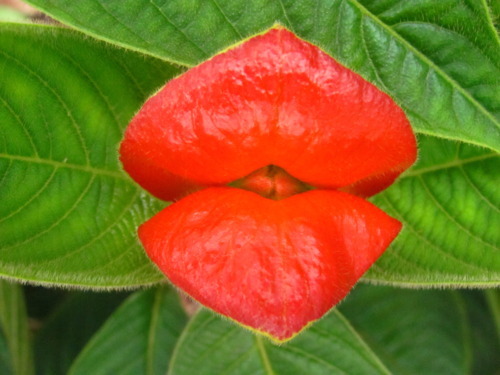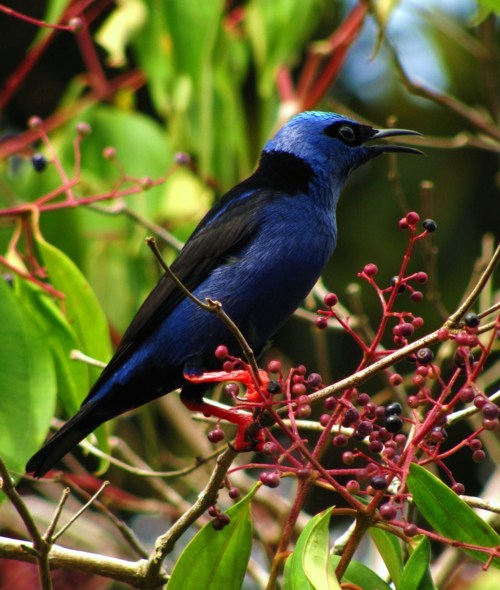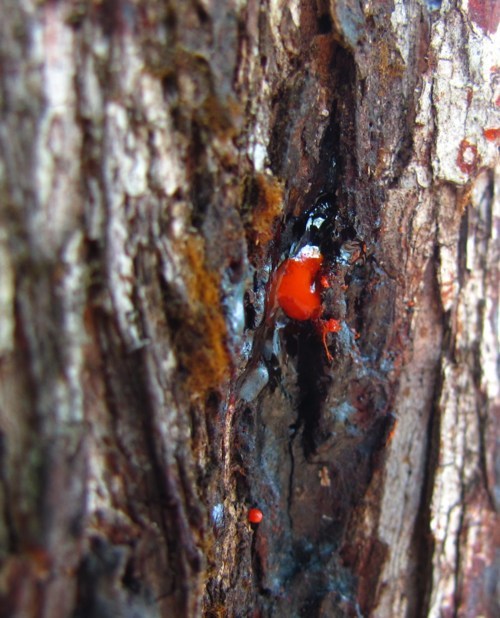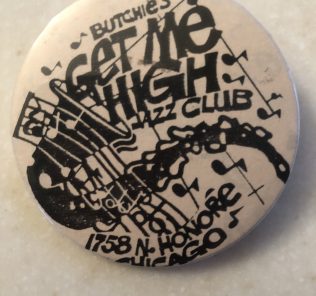American mirrors, Colombian gardens

The Red Lips at La Manigua Botanic Garden, Colombia.
They are used to make a poison—watch out. (Courtesy of Pilar Quintana)
MARCH 5, 2011——
The mirror in the hotel bathroom tells the truth.
Who is that old piece of bark? Why are there dark rings of time under those eyes?
Almost all hotel bathroom mirrors are washed over with bright light. It creates an in your-face effect you don’t get at home. Sometimes it may be the luster of a clean loo, other times it could be the magical distance from a known place.
In the mid-1980s I stayed at the Covent Hotel, a men’s only pay-by-the-week flophouse near Lincoln Park in Chicago. I have seen cypress trees made bare by lightning. These guys were like that.
The whole place smelled like mothballs. We had community bathrooms and those places were really dark. I spent more time in the mirror watching out for creepers moving around in unfortunate shadows.
Is that mole under that lip cancerous?
There’s a scar from a broken play in a distant football game where you tried to run for daylight.
You still move through the seasons with a sense of wonder that can betray your age.
Hardly anyone sends letters any more but on the return from a Valentine’s week vacation to Colombia there is a message from Pilar Quintana. You didn’t meet anyone named Pilar Quintana in Colombia. Who is this person?
She writes:
“I found your page in Tumblr and very much enjoyed your posts about Cali, more so since I know Suárez Fiat and Vicky Acosta. I’m from Cali also and I’m a writer myself (I have published three novels). My husband is originally from Northern Ireland but grew up in Australia. We’ve been living in Colombia’s Pacific Coast for over seven years now. After travelling around the world we ended up buying a beautiful piece of land on top of a jungle cliff here, built our wooden house and have been living a simple life since then.
One year ago we decided to do something with our lot and hence we created La Manigua Botanic Garden, where we protect its flora and fauna and share our knowledge of it with the visitors. In our Tumblr blog http://jardinbotanicolamanigua.tumblr.com/ you can get a taste of the place.
The reason I’m writing is to let you know we are here, in case you like nature and want to discover the very wild and beautiful Colombia’s Pacific Coast. So, please, take this as an invitation. I must tell you, though, that our sunsets are over warm waters.”
This is what you have looked for in the mirror: something to do with your lot.

The author lost in Bogota’.
Something about two people traveling together, joining their dreams at the hip and softly dancing into a blossoming future. There’s been some rough visits to Colombia, but you go back wanting to give it all another chance. You sense the warmth. The invitation makes you feel good and again believe in the will of that face in the mirror.
Pilar later sends a synopsis of her third novel, “Conspiracio’n Iguana,” a thriller set in an apartment building for yuppies owned by a guru that keeps them happy so they go motivated to work every day (I imagine like Facebook in Silicone Valley.)
The main character discovers a secret jungle on the roof top where renegades experiment with psychedelic Indian stuff like yage. The yage is the bitter-tasting psychedelic hooch they’ve been drinking around Bogota’ for decades. Writer/gun freak William Burroughs road tripped to Colombia in the 1950s in search of yage.
The renegades conspire to overthrow the guru and the main character jumps in the fray.

Pilar also sends pictures of her beautiful garden and intoxicating red lips.
There’s a humpback whale with a new born baby. Between July and November Humpback whales migrate to the warm waters of Colombia’s Pacific Ocean to mate and give birth.

There’s a red-legged honey creeper. It reminds you of that guy with the snoring problem next door on the third floor of the Covent. Did he pack heat in the coldest of places?
The final picture is the Bloodwood tree.

The tree is generally recognized by a crooked trunk and shiny green leaves. The tree naturally “bleeds” reddish sap and its “blood” is used to heal open wounds.
You know there is something very special in this garden.
You can’t wait to see it.





Leave a Response